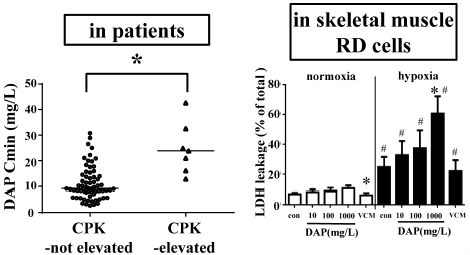- 著者
- Takehiro Yamada Shuhei Ishikawa Nobuhisa Ishiguro Masaki Kobayashi Ken Iseki
- 出版者
- The Pharmaceutical Society of Japan
- 雑誌
- Biological and Pharmaceutical Bulletin (ISSN:09186158)
- 巻号頁・発行日
- vol.43, no.9, pp.1338-1345, 2020-09-01 (Released:2020-09-01)
- 参考文献数
- 28
- 被引用文献数
- 2 3
Daptomycin, a cyclic lipopeptide antibiotic, has bactericidal activity against Gram-positive organisms and is especially effective against methicillin-resistant Staphylococcus aureus. Although daptomycin causes unique adverse drug reactions such as elevation of creatine phosphokinase or rhabdomyolysis, the detailed mechanisms underlying these adverse drug reactions in skeletal muscle are unclear. This study aimed to elucidate whether daptomycin causes direct skeletal muscle cell toxicity and investigate the relationship between daptomycin exposure and musculoskeletal toxicity. First, we evaluated the relationship between daptomycin exposure and skeletal muscle toxicity. Of the 38 patients who received daptomycin intravenously, an elevation in creatine phosphokinase levels was observed in five. The median plasma trough concentration of daptomycin in patients with elevated creatine phosphokinase levels was significantly higher than that in patients whose creatine phosphokinase levels were within the normal range, suggesting that increased exposure to daptomycin is related to elevation in creatine phosphokinase levels. In an in vitro study using human rhabdomyosarcoma cells, daptomycin reduced cell viability and increased membrane damage. These effects were more marked under hypoxic conditions. A necroptotic pathway seemed to be involved because phosphorylated mixed lineage kinase domain-like protein expression was enhanced following daptomycin exposure, which was significantly enhanced under hypoxic conditions. These findings indicate that daptomycin elicits cytotoxic effects against skeletal muscle cells via the necroptotic pathway, and the extent of toxicity is enhanced under hypoxic conditions.
